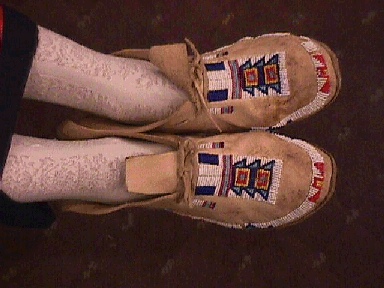
| Caddo page two. Back to page one. | Some Caddo Links. http://www.texasbeyondhistory.net/kids/caddo/index.html
This is a great Caddo web site on. Lots of picts and stuff to see
and do. http://www.tpwd.state.tx.us/park/caddoan/caddoan.htm |
Clothing and appearance
The Caddo grew cotton. They spun the threads and dyed the threads with vegetable dyes. The women would then weave beautiful cotton fabrics. They would use bead work and embroidery to decorate their clothing. Here are some beaded and embroidered moccasins.

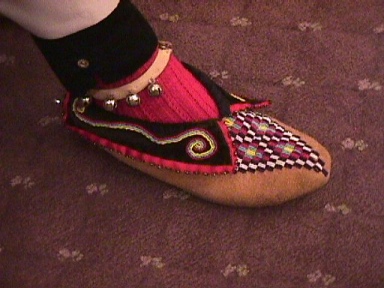
This pair of moccasins is traditional Caddo style.
 |
This is Billie Hoff, a Caddo Elder, in her traditional dress. Notice the beautiful shawl she has draped over her arm. Look at her turtle shell bag!! Kool ehh. Indian elders are given great respect by the younger members of the tribe. |
The Caddo also used leather in many ways. They would tan deer, buffalo, bear and other animal skins. The Caddo had a secret way of dying leather a lustrous black that only they knew. We think they used a plant to make this dye, but no one is sure any more.
The men would often shave their heads leaving a strip of hair down the middle. This hair was allowed to grow long down to the waist. They would then paint the shaved sides of their heads with colored paints. Another favorite men's hair style was to cut all the hair about 4 inches long except of a spot on the top on the head. Hair on this spot was allowed to grow long. Women grew their hair long and parted it in the middle. Some of them had a way of tying their hair in a curious knot behind their necks.
The men and women had many tattoos all over their faces and bodies. These tattoos show their membership in tribes, clans and societies.
Carved wood.
It is sad that wood rots and decays so fast in the region where the Caddo live. They made many beautiful wooden things. But these things are mostly gone now because they rotted away. The Spanish describe many carvings made from wood. They also made wooden bowls and wooden chests. Remember the chairs and the beds the Spanish liked so much? They were made from wood too. And remember the bois de arc wood bows? One of the prettiest things they made from wood were masks for ceremonies.

RELIGION
The Caddo were a part of a larger religious culture that is found all across the south and Midwest. This is the mound building religion/culture. They are called mound builders because that is what they did, built earth mounds - big ones. They put their temples and chief's houses on top of these mounds. Not all of the villages had mounds, just the most important ones. The Davis mound site is believed to be the most important mound site for the Hasinia. It is a Texas State Park now near Alto Texas and you can visit it.
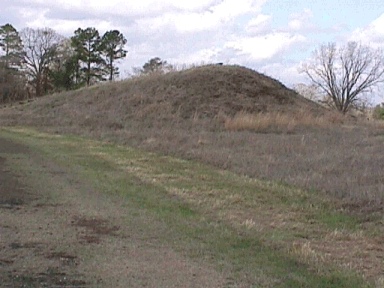
One of the mounds at Caddoan Mounds State Historic Site
Mound building to put temples and important building on the mounds was a widespread practice in the southern and Midwestern United States. Many other tribes built the same kind of mounds. One of these mounds, Monk's Mound, outside St.Louis is larger than the biggest pyramid in Egypt.
So the Caddo were practicing a religion that was shared by many other tribes such as the Creek, the Chickasaw, the Muscogeans, Think of a familiar model. The French, English, Germans, and Spanish all practice Christianity and build churches. Copyright by R E. Moore and Texarch Associates, all rights reserved. Well, many different Indian tribes like the Creeks, Chickasaws and Caddo also shared the same religion and built ceremonial mounds that are like Christian churches too them. Each tribe had its own special religious practices along with the shared practices.
All of the mound building tribes celebrated seasonal rites called busks. The fall busk is the most important of all the busks. The fall busk celebrates the bringing in of the crops and prepares for the winter. In many places the food crops would be brought in to a central place, where the important mound and temple was. During the ceremony the food would be redistributed so that everyone would get enough to get through the winter. Part of the ceremony was the new fire ritual.
All the fires in all the villages would be put out. Before putting the fires out people would burn and destroy worn out things they no longer needed. Kind of like a spring cleaning, only in the fall. During the ceremony the high priest would light a new fire and would share this new fire with everyone. People would carry this new fire many miles to their villages to light new fire there.
Fire was an important part of their religious tradition. Each house kept a sacred fire going all the time. At the main temple there was also a fire that burned all the time. These fires were built a special way. They would place four logs in the shape of a cross around the central fire. One log would point north, one east, one south and one west. As the fire burned the ends of these logs the people would push them in to the center. A home fire would have small logs and a dance ground would have big logs to last longer. Fire was believed to be a part of the sun and the sun represented the highest God. Here is the Southeastern Indian symbol for fire and the sun.
The arms are the logs and the small circle in the middle is the fire.
The Hasinai had a formal priesthood who took care of the temples on the mounds and who would lead the important ceremonies. There were also shamans who were not priests. The shamans specialized. Some of them were healers, others cast spells for making hunting easier or to help make war. Other shamans had visions to tell people what their fortunes were - just like astrologers do today.
The Caddo's favorite deities were the holy twins. It is said that the twins lived in the main temple at the Davis site. The high priest looked after them. The twins were very much loved because they carried the peoples prayers to heaven and pleaded for Gods to answer the Caddo people's prayers.
One branch of this religion was the Southeastern Ceremonial Cult. The cult seems to have been very popular from around a d 1000 to about 1400. The Southern Cult, as it is often called, is famous for its beautiful art work and crafts. The Caddo, and many other tribes as well, would use Southern Cult symbols and images to decorate many things.
Here are some designs from the Southeastern Ceremonial Cult.
Engravings from Conch Shell Black Drink Cups.
Shell Gorgets
Wee-Ta-Ra-Sha-Ro, Head Chief of the Wichita. The round plate hanging on his neck is a gorget. Painted by George Catlin in 1834
The Cult was a central part of the mound building cultures in East Texas from about a.d. 900 to 1300. These designs are from Spiro, a large and famous Caddo site just across the border in Oklahoma. Spiro was a large trade and ceremonial center on the Arkansas river in eastern Oklahoma. Spiro is famous for the beautiful design work engraved on shell. Most of these designs are on conch shell "black drink" cups. During the busk and at other ceremonies the Caddo would purify themselves by drinking the black drink out of cups made from large conch sea shells cut in half. The black drink is a tea made from a kind of holly leaves, along with other ingredients. Others designs are on round shell gorgets. A gorget is a disk that is worn on the neck. As soon as we get copyright permission from several sources, we plan to post a whole library of Southeastern Ceremonial designs and art.
Copyright by R E. Moore and Texarch Associates, all rights reserved.
MEN, WOMEN AND KIDS
In Caddoan society men hunted, built the houses, made war and defended the people. All of the chiefs and priest were men. Women gathered plant foods, cooked, tanned skins, tended the fields and took care of the small children. Kids started working and helping out as soon as they could. While kids could and did play games, they were much more like adults that in our society.
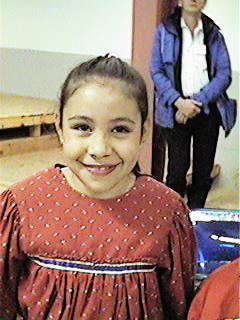 |
|
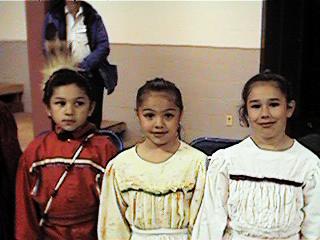 |
|
 |
HISTORY
The Spanish liked the Caddo because they were so civilized. The first European contact with the Caddo was the DeSoto expedition. DeSoto and his Spaniards entered Caddo territory in 1541. They lived with the Caddo for a season. This spread European diseases among the Caddo and many of them died. The first Spanish missions were in Nacogdoches in the middle of the Hasinai Caddo. Because of the Spanish missions we have some good written accounts of Caddoan society. Later other tribes fleeing the Americans east of Texas moved into the Caddoan area. The Cherokee came in 1823 and the Alabama and the Coushatta came soon after. The Caddos always tried to be peaceful, but Europeans wanted their land. Sam Houston, who was an adopted Cherokee, tried hard to protect the Caddo and the other tribes. He made Texas honor treaties and enforced the laws to protect the Indians. After he left office things got worse. White people who lived around the Caddo would steal Indian cattle and hogs. They treated the Caddo very badly. Some of the whites intentionally provoked the Caddo into fighting. The government used this fighting as an excuse to force all the Caddo to move from their land.In the early 1840s, most of the Caddo moved west to the Brazos river reservations along with many other Texas tribes. They did this to get away from the hostile white people around them in east Texas. Even on the Brazos reservation they still had trouble with their white neighbors. In 1855 most of the Indians on the reservation were forced to flee to Indian Territory in what is now Oklahoma. A smaller group of about 1000 Caddo followed in 1859.
| REALITY CHECK; Look at what is happening here. The Caddo and other east Texas Indians, such as the Cherokee, are living as peaceful farmers in east Texas. It is the white settlers around them who are doing most of the stealing, and violence. Today we would call these crimes racial hate crimes. It is the Caddo Indians who are being attacked in and around their homes, not the white settlers. It is the Caddo and other Indians who are forced out of their homes and off their land. It is the Caddo and other Indians who have to flee for their safety. How does this compare with the usual way Indians are shown to us? In movies, on TV and in many stories in books and magazines the Indians are the violent aggressors. The whites are the victims. NOT TRUE. The TRUTH is the Indians were the victims, not just in east Texas, but everywhere else too. |
In the Indian Territory, the Caddo were placed on the Wichita reservation. They left the Wichita reservation during the civil war from 1861 to 1867. In 1867 they returned to the Wichita reservation and in 1874 they were given their own Caddo reservation.
In 1893 the Dawes Commission was set up by the United States Government to get the Indian tribes to give up their reservations and tribal governments. The Dawes Commission thought the best way to destroy the old Indian culture was to privatize Indian land. They wanted to divide up the Indian's land and give an allotment to each Indian family. Allotment means dividing something up and allotting (giving) the parts to individuals. An allotment is like a share. The Indians did not like this and argued against it. The land that was not allotted was to be sold to white settlers and there was a lot of it. White settlers wanted the Indian land.
In 1901 the United States Government dissolved the Caddo reservation under the Dawes Act and divided the land up among the families. This division of the land was called allotment. Each family was given 160 acres of land that they owned. Before this the tribe owned all the land as is common on Indian reservations. Allotment means dividing something up and allotting (giving) the parts to individuals. An allotment is like a share. This is when tribal members were officially enrolled (listed) as members of the tribe. This was done by the United States Government. You had to be an enrolled tribal member to get an allotment of land. Many Caddo who did not want land or who refused to participate in an American Government controlled program did not enroll. People still argue today about who is and who is not a Caddo because of the Caddo who did not enroll. All the land that was not allotted, and there was a lot of it, was taken by the United States Government and sold to the railroads and to white settlers.
The whole purpose of the Dawes commission was to destroy the tribes. Dissolving the reservations and tribal governments was supposed to force the Indians to forget their past culture and heritage and live like Whites. Of course back then there were laws that made them second class citizens because of their race. Indians were discriminated against and treated much the same as black people were treated, even worse in many cases. Many Caddo were passing as white persons back then and this is one reason many of them did not enroll.
For you younger readers, there were many laws and customs in 1901 that discriminated against what were called "persons of color" or colored persons. Persons of color were Africans, Mexicans, Chinese and of course Indians. Of course the term colored means their skin was not white. There were laws back then called Jim Crow laws that banned colored persons from sitting in or eating in white only restaurants. Persons of color were not allowed in the city limits of many towns after dark. Businesses could refuse to do business with them and did so. In some places Jim Crow laws required persons of color to always be employed or be sent to prison to work on convict labor gangs. Persons of color or "coloreds' as they were called by whites were not allowed to vote, could not hold elected office, and were not allowed to sue or use the court system. Their children had to go to substandard colored schools and often had no schools. Many jobs and professions were forbidden to coloreds. Most colleges in the south refused colored students by law. In most towns they had to live in colored sections of town and could not buy or live in white only parts of town. So, if an Indian could pass as being white they did. Many did not want to enroll and come under the Jim Crow laws.
The allotted land the Indians were supposed to own was not really theirs. The land was held in trust for each Indian by the United States Government. This means the government could sell the land without the permission of the Indian who was supposed to own the land. The government also held onto the money from any such sale, in trust. The Indian could not sell the land without the permission of the Government. The Government had full management of the allotted land. In many cases Indian land was sold to railroads and whites against the wishes of the Indian owner.
The Burke Act of of 1906 ended the holding in trust of Indian lands, but added a new twist. The Burke Act declared all Indians incompetent to manage their affairs. An Indian had to get a certificate of competency to manage his or her land. Until an Indian was declared competent the government managed his or her land and financial affairs, just like the old trust system. Some Caddo were educated professionals by this time. Even these persons were held to be incompetent till the applied for and passed the tests to be certified competent.
The Caddo descendants still live on allotted land around Binger Oklahoma.
This is Mrs. Larue Parker. She is chairperson (2000) of the Caddo tribe. Like the modern Caddo, she wears ordinary American clothes, not buckskin and feathers. She is a well educated modern woman. She is married (to a Comanche) and has grown children. As Chairperson she is working to improve things for her people.
The modern Caddo now live around Anadarko and Binger Oklahoma. They are prospering and doing well. I have been there and went to see the school the Caddo children go to. They have a nice school. The Caddo now live like middle class Americans. They go to work and school and watch TV. The kids and teenagers like to go to McDonalds and have hamburgers. On weekends the play baseball and soccer or go to a movie. But as Caddos, they also go to traditional tribal activities where they sing Caddo songs and dance traditional Caddo dances. The older people try hard to teach the younger people to speak the Caddo language and learn the Caddo traditions. The older Caddo know that their Caddo culture is the most valuable thing they can pass on to the younger people. The Caddo are still keeping their culture and traditions alive.
Check this other Caddo site out too. It's a good one.
Click here to go to a web page presenting a Texas Park Service book on the Davis Caddo Indian site. The site is by Bob Skiles and the book is by Jerry M. Sullivan . A really great site with lots of pictures. So good we put the link here.
Caddo language
Pay attention : da-wee-cha-sun
Come here : da-yah
You are out of your mind : Coo-sah-oh-na-ah-nit
Alligator : koo-hooh
Bird : banit
Cat : mee yu
Deer : da
Dog : deet see
Fish : batah
Raccoon : ut
Skunk : wehit
Turkey : naw
Worm : koo-ooh
Beans : dabas
Corn : kisi
Pumpkin : ka-kee-kus-nee
Sugar : ha-bit-tso
Black : ha deek ko
Blue : bahnushahah
Green : ba-noo-sha
Purple : dakank'uh
Red : hatinu
White : hakaayu
Yellow, Orange : hak'ayk'u
1 : wist see
2 : bit
3 : dah hoe
4 : hee weh
5 : dee sik uhn
Back to home page
at www.texasindians.com
Copyright
by R E. Moore and Texarch Associates, 1998, 2000,2001. All rights reserved.
Graphics may not be used or reproduced without prior permission. Short parts
of text may be quoted in school reports. Longer quotes require prior written
permission.